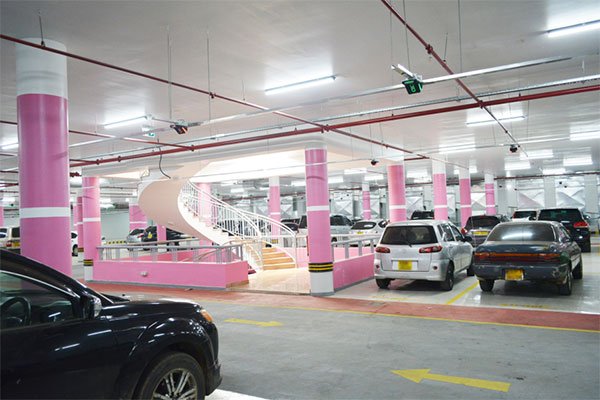The Archdiocese of Nairobi has opened an innovative parking facility at the Holy Family Minor Basilica. The modern underground structure, initiated through the guidance of His Eminence John Cardinal Njue, is a creative way of providing motorists with additional, convenient and secure parking spaces within the city centre.
Father Simon Ng’ang’a, the finance administrator at the Archdiocese of Nairobi, says feasibility studies on the project started in 2012. At that time, it was established that Nairobi had a parking deficit of over 9,000 spaces each day, Father Ng’ang’a says.
The team decided that provision of additional parking spaces would come in handy, not only for the congregants, but also as an extra source of revenue to support the church’s evangelisation and social work such as the furtherance of education, medical services, charity and other community support initiatives.
Now complete, the new parking facility at Holy Family Minor Basilica has a capacity of 516 slots, split into four levels underground. The church has beefed up security following the opening of the parking to the public.
“There is a lot of screening for pedestrians and drivers at the point of entry. We have also increased the number of security guards and armed security officers on patrol,” says Father Ng’ang’a.
The decision to build parking slots below the ground was born out of a need to preserve the original look and feel of the Basilica and also not to interfere with the core business of the church.
“Our core business is worship. We didn’t want to create a building and block the frontage of the church, but rather to preserve its design and façade,” Father Ng’ang’a elaborates.
Bearing in mind that the church had no other land within the city centre, excavation was the most optimal thing to do. His Eminence John Cardinal Njue challenged the leadership of the church to think through the concept of having the parking area underground.
“A team of professional building consultants came on board and carried out a geological survey to see if our idea could work,” Father Ng’ang’a narrates. The Archdiocese also commissioned professional project consultants.
They included MML and Townsend (as project managers), Trioscape Space Planning Services (architects), Laurez and Associates (quantity surveyors), Frame Consultants (civil structural engineers) and Geomax Consulting Engineers (electrical and mechanical engineers).
After much research, the team resolved that an underground parking lot was viable at the location. The proposal was to choose between three models of underground parking facilities: Fully mechanised, semi-mechanised or the conventional model.
“The fully mechanised model would have pushed up the costs, and for us to break even, we would have to ensure that the slots were over 600.
The county government couldn’t approve over 600 parking slots because of the challenge of traffic management in Nairobi,” says Father Ng’ang’a.
The church therefore opted for the conventional parking model as it was economically viable.
The facility is one of a kind in Nairobi. It features automated access control for entry and exit and grants access to authorised vehicles only. This enhances the safety of parked vehicles.
Drivers will also be able to access the parking facility using temporary barcode tickets or prepaid cards. The latter will enable drivers to have a tap-and-go experience without having to pass by the pay stations.
The facility has an intelligent parking guidance system (PGS), which combines traffic monitoring, communication, processing and information dissemination technologies to give drivers dynamic, real-time information about space availability.
The system utilises outdoor and indoor occupancy signs as well as bay indicators to guide drivers to free spots. This eases parking.
These special features bring unmatched convenience to the facility. Besides, parked vehicles are sheltered from small thefts, riots and adverse weather.
The area is served by two lifts. This makes it accessible to persons who are physically challenged. All the four levels are fitted with enough air conditioning machines, fire-fighting equipment and carbon detectors. There is CCTV surveillance, 24/7.
The lighting system has sensors that detect and adjust the level of lighting as deemed optimum. The Basilica is using solar power at the facility to cut energy costs. Additionally, the parking silo is served by a helical staircase that uses glass to allow natural light to penetrate to the fourth level.
There are charging areas for electric cars. On standby is a power back-up generator for the entire parking facility.
Competitive pricing
The facility provides for both long-term and short-term parking contracts. “We are giving a discounted rate in 2020,” says Father Ng’ang’a. A parking slot goes for Sh500 for a day. Motorists with pre-paid cards can park multiple times throughout the day up to 11pm.
Corporate companies and SMEs who have several cars will enjoy parking space for Sh15,000 per car per month. The rates go lower depending on the number of cars. This is competitive pricing, given that in Nairobi’s CBD, parking bays go for as much as Sh19,000 a month. Tenants at Cardinal Otunga Plaza will benefit for an even friendlier rate of Sh12,000 per car per month.
For short-term parking, the first two hours will cost Sh100. The third and fourth hours will push the cost to Sh300 and Sh400 respectively. From five hours onwards within the day, the cost will be Sh500.
Therefore, visitors on short stay at the Cardinal Otunga Plaza, which has conferencing facilities and meeting rooms on lease, are well catered for.
The facility’s location is also strategic for guests attending meetings and conferences within Nairobi CBD. It offers exclusivity and is within quick reach of exit routes – Uhuru Highway and Mombasa Road.
It is expected that the church will recoup its Ksh870 million capital invested in the project and break even within five years.




